How Does A Metamorphic Rock Look Like? Metamorphic rocks are a fascinating category of rock, transformed from existing rock types by intense heat, pressure, or chemically active fluids. At rockscapes.net, we’ll explore the varied appearances of these geological wonders, offering inspiration for your landscape designs and providing a comprehensive understanding of their formation. Let’s dive into the captivating world of these altered stones, where beauty meets resilience.
1. What Are Metamorphic Rocks and How Are They Formed?
Metamorphic rocks are rocks that have been changed by extreme heat and pressure. Metamorphism occurs when pre-existing rocks, known as protoliths, are subjected to conditions different from those in which they originally formed. These conditions can include high temperature, high pressure, and the presence of chemically active fluids.
- Heat: Temperature increases with depth within the Earth. This heat can cause atoms within minerals to vibrate more vigorously, allowing them to move and rearrange.
- Pressure: Pressure also increases with depth. Confining pressure, which is equal in all directions, can cause chemical reactions to occur and new minerals to form. Directed stress, which is unequal in different directions, can cause minerals to align, creating foliation.
- Fluids: Chemically reactive fluids, such as water and carbon dioxide, can also play a role in metamorphism. These fluids can react with minerals, changing their composition and allowing elements to move more freely.
According to research from Arizona State University’s School of Earth and Space Exploration, metamorphic processes are pivotal in reshaping the Earth’s crust, influencing the texture and mineral composition of rocks under intense geological conditions.
2. What Is the Role of the Protolith in Metamorphic Rock Formation?
The protolith is the original rock that undergoes metamorphism. The composition and texture of the protolith play a significant role in determining the final appearance of the metamorphic rock.
- Sedimentary Rocks: Sedimentary rocks like shale can transform into slate, phyllite, schist, and gneiss with increasing metamorphic grade. Limestone and dolostone can become marble.
- Igneous Rocks: Igneous rocks like granite can become gneiss. Basalt can transform into greenschist or blueschist under specific pressure-temperature conditions.
- Other Metamorphic Rocks: Metamorphic rocks can also undergo further metamorphism, resulting in new metamorphic rocks with different characteristics.
The initial composition of the protolith greatly influences the resulting metamorphic rock, as the elements and minerals present in the original rock dictate which new minerals can form under metamorphic conditions.
3. What Are the Different Types of Metamorphism?
Metamorphism can occur in various geological settings, leading to different types of metamorphic rocks.
- Regional Metamorphism: This occurs over large areas and is typically associated with mountain building. Rocks are subjected to high temperatures and pressures due to burial and tectonic forces.
- Contact Metamorphism: This occurs when magma intrudes into existing rock. The heat from the magma causes changes in the surrounding rock.
- Burial Metamorphism: This occurs when rocks are buried deep within the Earth’s crust. The increasing temperature and pressure cause changes in the rock.
- Subduction Zone Metamorphism: This occurs in subduction zones, where one tectonic plate slides beneath another. The high pressure and low temperature conditions create unique metamorphic rocks.
- Fault Metamorphism: This occurs along fault lines, where rocks are subjected to intense shear stress.
- Shock Metamorphism: This occurs when a meteorite impacts the Earth. The extreme pressure and temperature cause rapid changes in the rock.
Understanding these different types of metamorphism helps geologists interpret the geological history of a region and the processes that have shaped the rocks found there.
4. What Is Metamorphic Grade and How Does It Affect Rock Appearance?
Metamorphic grade refers to the intensity of metamorphism, which is determined by the temperature and pressure conditions.
- Low-Grade Metamorphism: This occurs at relatively low temperatures and pressures. The resulting rocks show subtle changes in mineral composition and texture.
- High-Grade Metamorphism: This occurs at high temperatures and pressures. The resulting rocks show significant changes in mineral composition and texture, often with the formation of new minerals.
The metamorphic grade influences the appearance of the rock, with higher-grade rocks typically exhibiting more pronounced foliation or banding and larger crystal sizes. Index minerals, such as chlorite, muscovite, biotite, garnet, and staurolite, are used to identify metamorphic grade, providing clues about the conditions under which the rock formed.
5. What Are Foliated Metamorphic Rocks and What Are Their Characteristics?
Foliated metamorphic rocks exhibit a layered or banded appearance due to the alignment of mineral grains.
- Slate: A fine-grained rock with a flat, sheet-like structure called slaty cleavage.
- Phyllite: A rock with a slightly coarser grain size than slate, exhibiting a silky sheen on its surface.
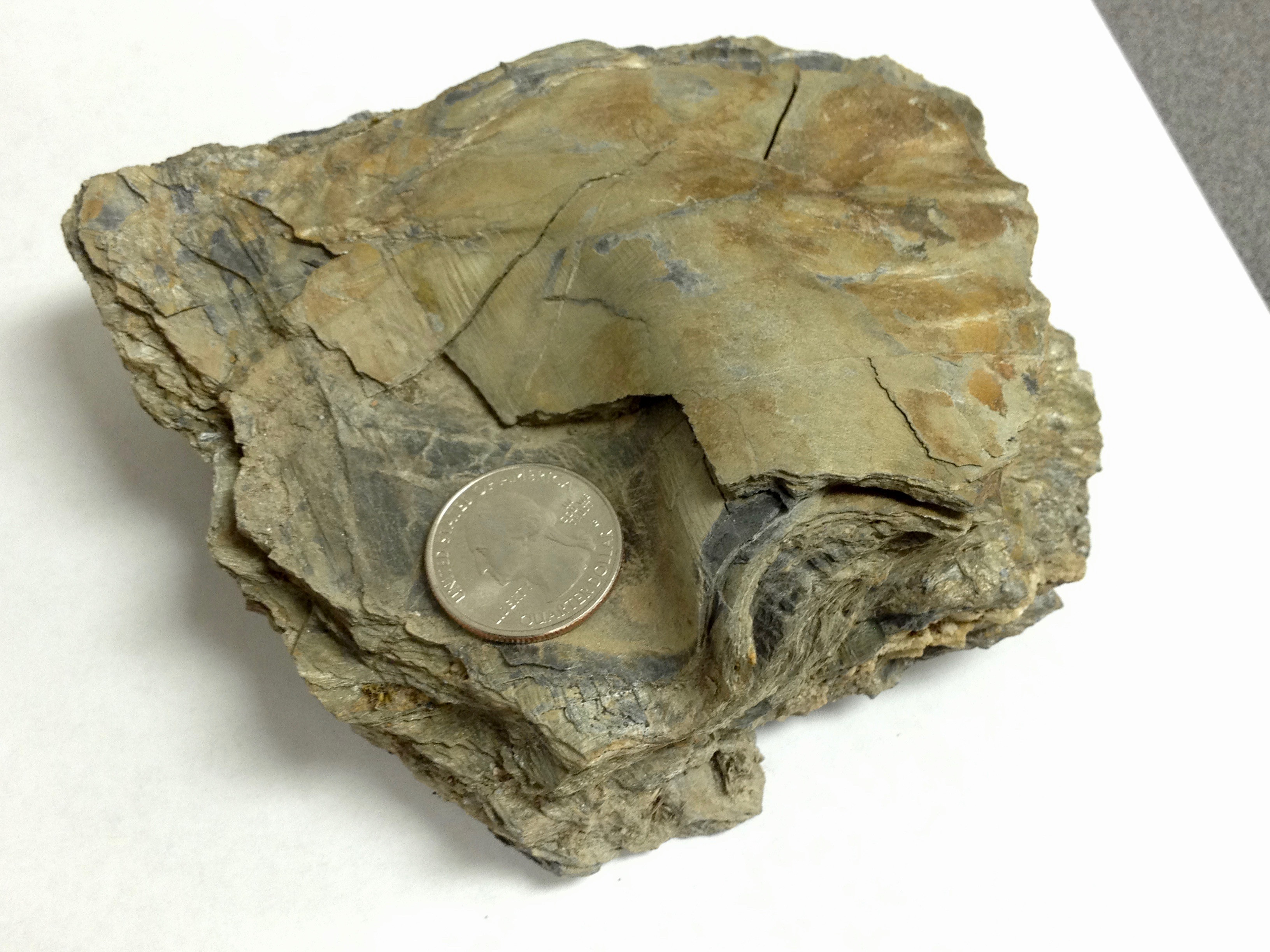 Phyllite with a small fold, showcasing its sheen and texture
Phyllite with a small fold, showcasing its sheen and texture
- Schist: A rock with visible, platy minerals aligned in parallel layers, giving it a scaly appearance.
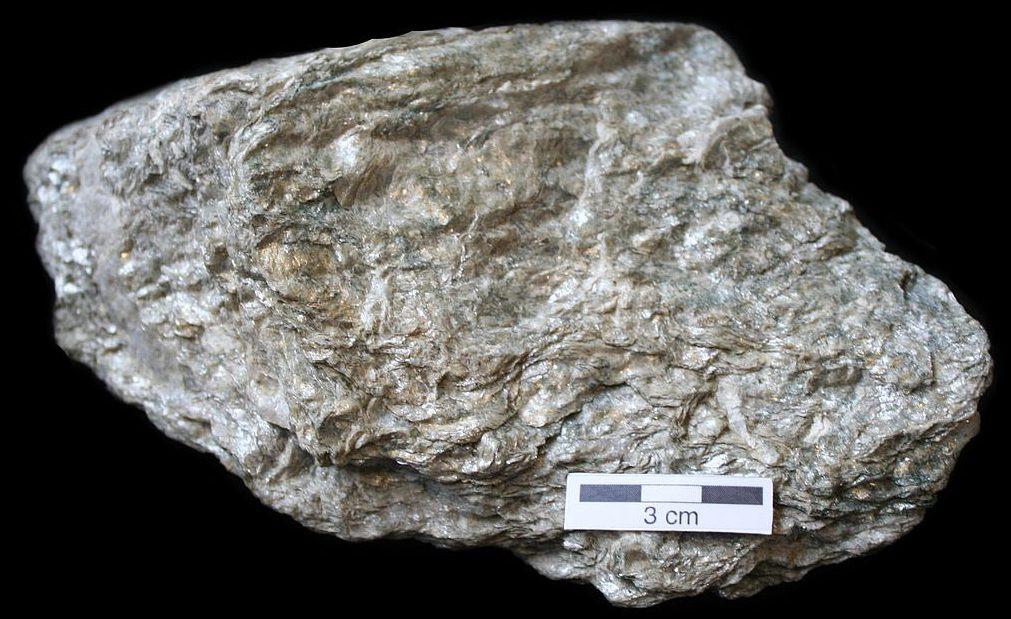 Detail of Schist showcasing visible mineral alignment
Detail of Schist showcasing visible mineral alignment
- Gneiss: A coarse-grained rock with distinct bands of light and dark minerals.
 Gneiss showcasing distinct bands of light and dark minerals
Gneiss showcasing distinct bands of light and dark minerals
Foliation is caused by directed stress, which aligns minerals perpendicular to the direction of the stress. These rocks are commonly used in landscaping for their unique textures and visual appeal.
6. What Are Non-Foliated Metamorphic Rocks and What Are Their Characteristics?
Non-foliated metamorphic rocks lack a layered or banded appearance.
- Quartzite: A hard, dense rock formed from metamorphosed sandstone, composed primarily of quartz.
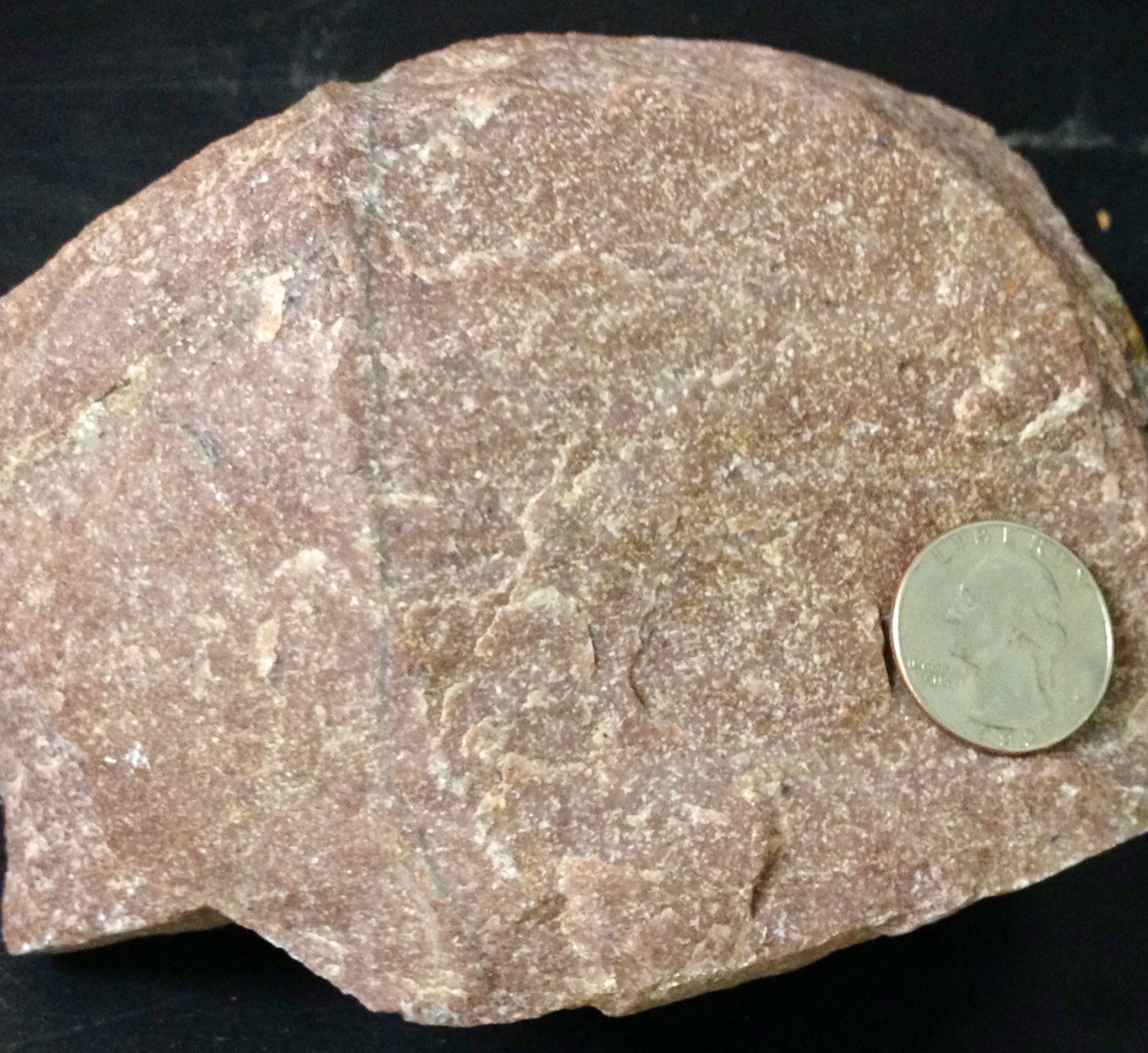 Baraboo Quartzite showing interlocking crystal structure
Baraboo Quartzite showing interlocking crystal structure
-
Marble: A rock formed from metamorphosed limestone or dolostone, composed primarily of calcite or dolomite.
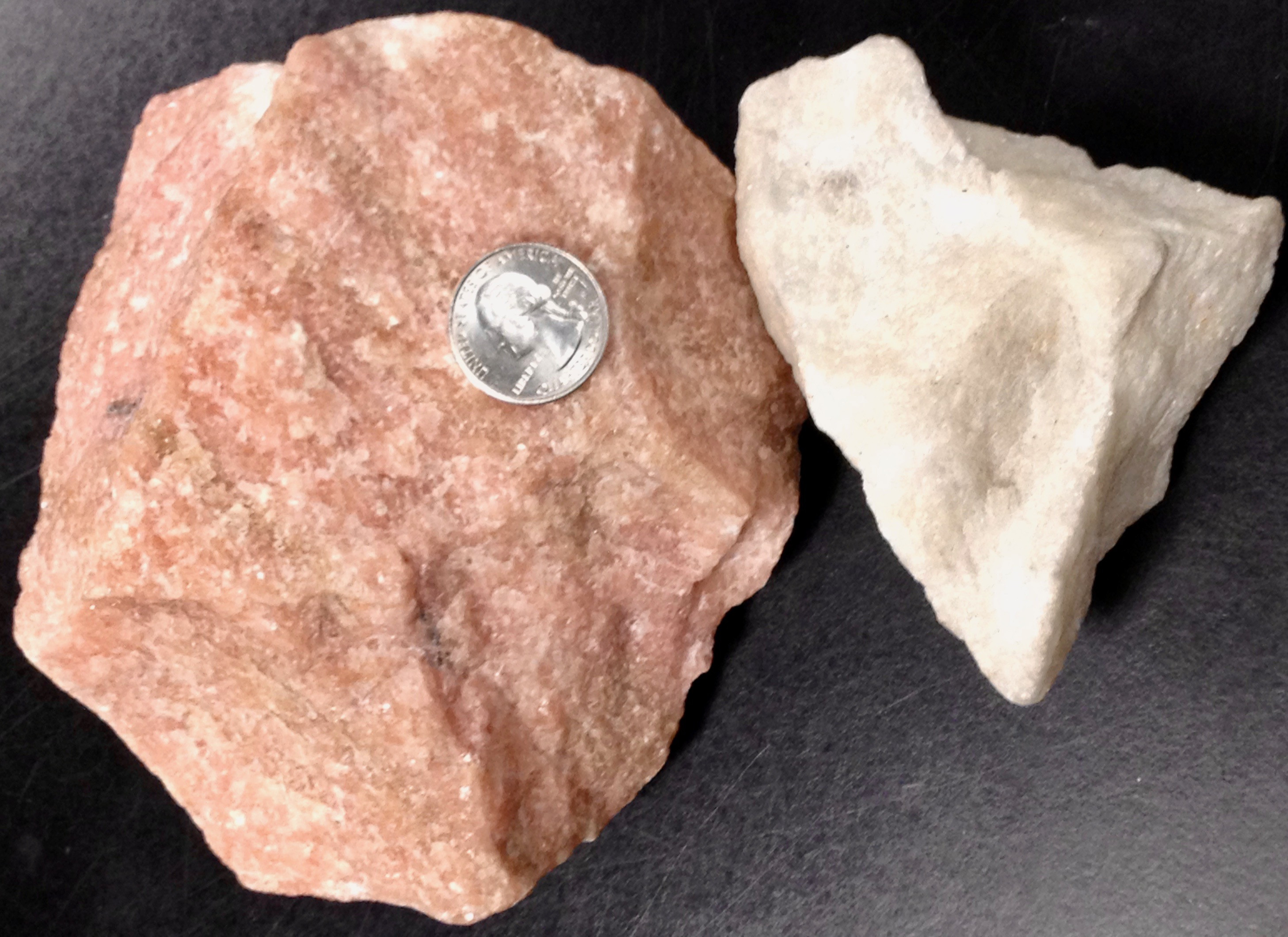 Marble showing crystalline texture
Marble showing crystalline texture -
Hornfels: A fine-grained, dense rock formed from the contact metamorphism of various protoliths.
Non-foliated rocks form when there is no directed stress or when the protolith lacks platy minerals. These rocks are valued in construction and landscaping for their uniform appearance and durability.
7. How Does the Color of Metamorphic Rocks Vary?
The color of metamorphic rocks depends on the minerals present and their chemical composition.
- Slate: Typically gray or black due to the presence of carbonaceous material.
- Phyllite: Similar to slate, but may have a greenish tint due to chlorite.
- Schist: Can be various colors depending on the minerals present, such as mica (silver or brown) or garnet (red).
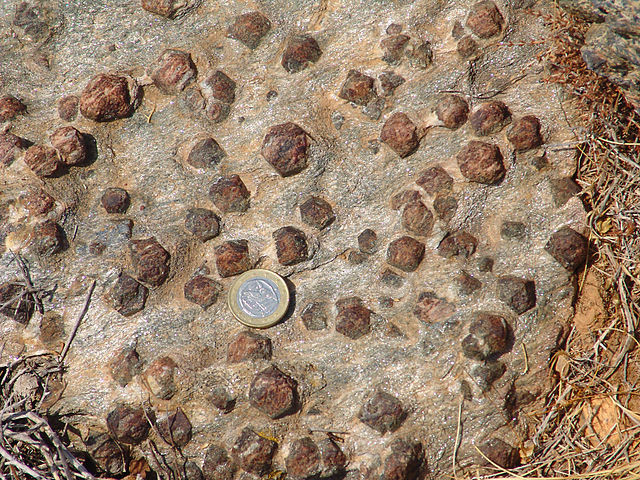 Garnet Schist showing large weathered garnet crystals
Garnet Schist showing large weathered garnet crystals
- Gneiss: Typically has alternating light and dark bands, with colors ranging from white and pink (feldspar) to black and brown (biotite or hornblende).
- Quartzite: Can be white, gray, pink, or red depending on the presence of impurities.
- Marble: Can be white, gray, pink, green, or black depending on the impurities present.
- Blueschist: Distinctive blue color from the presence of the mineral glaucophane.
The color variations in metamorphic rocks make them aesthetically pleasing for landscaping and architectural applications.
8. How Do Metamorphic Rocks Differ in Texture?
Texture refers to the size, shape, and arrangement of mineral grains in a rock. Metamorphic rocks exhibit a wide range of textures.
- Fine-Grained: Rocks like slate and phyllite have small mineral grains that are difficult to see with the unaided eye.
- Medium-Grained: Rocks like schist have mineral grains that are visible but not particularly large.
- Coarse-Grained: Rocks like gneiss have large mineral grains that are easily visible.
- Porphyroblastic: Some metamorphic rocks contain large crystals (porphyroblasts) surrounded by a finer-grained matrix.
- Granoblastic: Non-foliated rocks like quartzite and marble have a granoblastic texture, with interlocking, equidimensional grains.
The texture of a metamorphic rock provides valuable information about its formation and the conditions under which it formed.
9. What Are Some Common Minerals Found in Metamorphic Rocks?
Metamorphic rocks contain a variety of minerals, depending on the protolith and the metamorphic conditions.
- Mica: Muscovite and biotite are common in foliated rocks like schist and gneiss.
- Quartz: A major component of quartzite and gneiss.
- Feldspar: Orthoclase and plagioclase are common in gneiss.
- Garnet: A common porphyroblast in schist.
- Staurolite: Another common porphyroblast in schist.
- Calcite and Dolomite: The main minerals in marble.
- Chlorite: Common in low-grade metamorphic rocks.
- Glaucophane: A characteristic mineral in blueschist.
These minerals provide clues about the metamorphic grade and the type of metamorphism that occurred.
10. What Are Metamorphic Facies and How Do They Relate to Rock Appearance?
Metamorphic facies are sets of mineral assemblages that are stable under specific pressure-temperature conditions.
- Greenschist Facies: Low-grade metamorphism, characterized by the presence of chlorite, epidote, and actinolite. Rocks typically have a greenish color.
- Amphibolite Facies: Medium-grade metamorphism, characterized by the presence of amphibole and plagioclase. Rocks typically have a dark color.
- Granulite Facies: High-grade metamorphism, characterized by the presence of pyroxene and garnet. Rocks typically have a coarse-grained texture.
- Blueschist Facies: High-pressure, low-temperature metamorphism, characterized by the presence of glaucophane. Rocks have a distinctive blue color.
- Eclogite Facies: Very high-pressure metamorphism, characterized by the presence of garnet and omphacite. Rocks are dense and have a dark green color.
The metamorphic facies provide a framework for understanding the conditions under which metamorphic rocks form and how these conditions influence their appearance.
11. How Does Contact Metamorphism Influence Rock Appearance?
Contact metamorphism occurs when magma intrudes into existing rock, creating a zone of altered rock around the intrusion known as a contact aureole.
- Hornfels: Fine-grained, dense rock formed from the metamorphism of shale or basalt.
- Marble: Formed from the metamorphism of limestone or dolostone, often with larger crystal sizes than the original rock.
- Quartzite: Formed from the metamorphism of sandstone, with interlocking quartz grains.
The appearance of contact metamorphic rocks varies depending on the protolith and the temperature of the intrusion. The metamorphic changes are most pronounced closest to the intrusion, creating concentric bands with contrasting mineralogy.
12. What Role Does Regional Metamorphism Play in Shaping Rock Appearance?
Regional metamorphism occurs over large areas and is typically associated with mountain building, resulting in significant changes to the appearance of rocks.
- Foliation: Directed stress causes minerals to align, creating foliated textures like slate, phyllite, schist, and gneiss.
- Index Minerals: The presence of index minerals like chlorite, muscovite, biotite, garnet, and staurolite indicates the metamorphic grade and temperature-pressure conditions.
- Banding: Gneissic banding is a distinctive feature of high-grade regional metamorphic rocks, with alternating bands of light and dark minerals.
Regional metamorphism transforms large volumes of rock, creating mountain ranges with distinct metamorphic zones and rock appearances.
13. How Does Subduction Zone Metamorphism Affect Rock Appearance?
Subduction zone metamorphism occurs when one tectonic plate slides beneath another, creating a unique environment of high pressure and low temperature.
- Blueschist: Rocks formed under these conditions are characterized by the presence of the blue-colored mineral glaucophane, giving them a distinctive appearance.
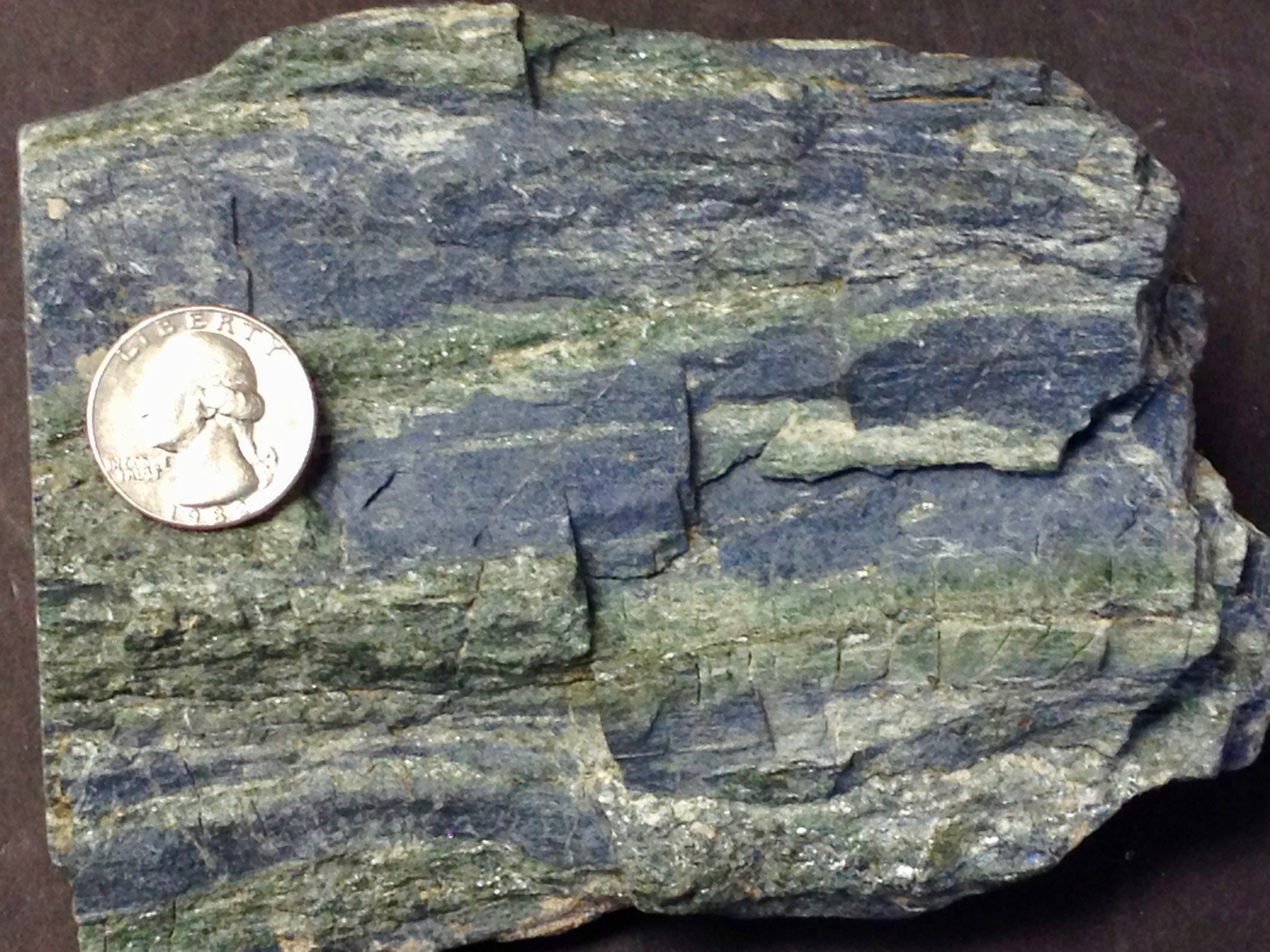 Blueschist showing distinctive blue color and foliation
Blueschist showing distinctive blue color and foliation
- Eclogite: Formed at even higher pressures, eclogites are dense, dark green rocks composed of garnet and omphacite.
The unique pressure-temperature conditions in subduction zones result in metamorphic rocks with unusual mineral assemblages and appearances.
14. What Visual Clues Distinguish Fault Metamorphism Rocks?
Fault metamorphism occurs along fault lines, where rocks are subjected to intense shear stress, creating distinct textures.
- Mylonites: These rocks are formed by dynamic recrystallization, with mineral grains ground and stretched out in the direction of the shear stress.
- Augen: Larger, stronger crystals like feldspar and quartz may be sheared into asymmetrical eye-shaped crystals called augen.
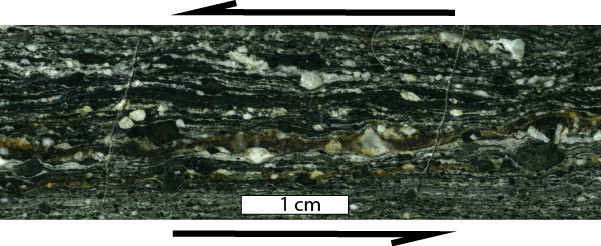 Augen Gneiss with eye-shaped crystals
Augen Gneiss with eye-shaped crystals
- Cataclasites: Chaotically crushed mixes of rock material with little internal texture.
- Rock flour: Rocks ground up to a fine particle size.
The textures created by fault metamorphism provide evidence of the intense forces acting along fault lines.
15. What Is Unique About the Appearance of Shock Metamorphism Rocks?
Shock metamorphism occurs when a meteorite impacts the Earth, creating extreme pressure and temperature conditions.
- Shock Laminae: Narrow planes of glassy material with distinct orientations found in silicate mineral grains.
- Shatter Cones: Cone-shaped pieces of rock with lines that converge to cone shapes.
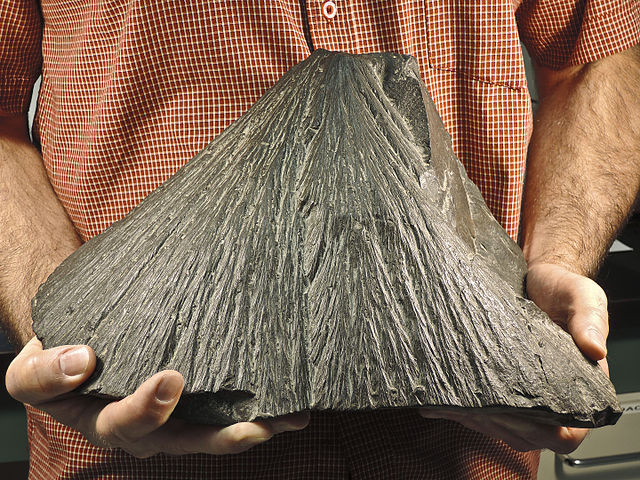 Shatter Cones showing cone-shaped features
Shatter Cones showing cone-shaped features
- Tektites: Gravel-size glass grains ejected during the impact event.
These features are unique to shock metamorphism and provide evidence of the extreme forces involved in meteorite impacts.
16. How Do I Identify Metamorphic Rocks?
Identifying metamorphic rocks involves examining their texture, mineral composition, and color.
- Texture: Determine whether the rock is foliated or non-foliated. Look for features like slaty cleavage, schistosity, gneissic banding, or granoblastic texture.
- Mineral Composition: Identify the minerals present in the rock. Common minerals include mica, quartz, feldspar, garnet, and calcite.
- Color: Note the color of the rock and any color variations. The color can provide clues about the minerals present.
Using a combination of these characteristics, you can identify the type of metamorphic rock and learn about its formation. A metamorphic rock identification table can also be a helpful tool.
17. How Are Metamorphic Rocks Used in Landscaping?
Metamorphic rocks are widely used in landscaping for their unique textures, colors, and durability.
-
Slate: Used for paving stones, roofing tiles, and wall cladding.
-
Quartzite: Used for decorative stones, retaining walls, and pathways.
-
Marble: Used for sculptures, fountains, and decorative accents.
-
Gneiss: Used for retaining walls and decorative stones.
The use of metamorphic rocks in landscaping adds natural beauty and character to outdoor spaces.
18. How Can I Incorporate Metamorphic Rocks into My Garden Design?
Incorporating metamorphic rocks into your garden design can create a unique and visually appealing landscape.
-
Rock Gardens: Use a variety of metamorphic rocks to create a natural-looking rock garden.
-
Pathways: Use slate or quartzite for pathways and stepping stones.
-
Water Features: Use marble or quartzite for water features like fountains and ponds.
-
Retaining Walls: Use gneiss or quartzite for retaining walls.
Experiment with different types of metamorphic rocks to create a garden design that reflects your personal style.
19. Where Can I Find Metamorphic Rocks for My Landscaping Project in the USA?
Metamorphic rocks can be found in various regions of the USA, depending on the type of rock.
- Slate: Found in Pennsylvania, Vermont, and New York.
- Quartzite: Found in Wisconsin, South Dakota, and Arizona.
- Marble: Found in Vermont, Georgia, and Colorado.
- Gneiss: Found in the Appalachian Mountains and the Canadian Shield.
- Blueschist: Found in California Coast Range.
Contact local quarries and stone suppliers to find the specific types of metamorphic rocks you need for your landscaping project.
20. What Are the Benefits of Using Metamorphic Rocks in Landscaping?
Using metamorphic rocks in landscaping offers several benefits.
- Durability: Metamorphic rocks are highly durable and resistant to weathering, making them ideal for outdoor use.
- Aesthetic Appeal: The unique textures, colors, and patterns of metamorphic rocks add natural beauty and character to landscapes.
- Variety: Metamorphic rocks come in a wide range of types, allowing you to create a diverse and visually appealing landscape.
- Low Maintenance: Metamorphic rocks require little maintenance, making them a practical choice for landscaping.
By incorporating metamorphic rocks into your landscaping project, you can create a beautiful and long-lasting outdoor space.
FAQ: Understanding Metamorphic Rocks
- What is the main difference between metamorphic and igneous rocks?
The main difference is that metamorphic rocks are formed from existing rocks that have been changed by heat, pressure, or chemically active fluids, while igneous rocks are formed from the cooling and solidification of magma or lava. - Can metamorphic rocks turn back into sedimentary rocks?
Yes, metamorphic rocks can be weathered and eroded into sediments, which can then be lithified to form sedimentary rocks. - How can I tell the difference between slate and shale?
Slate has a flat, sheet-like structure called slaty cleavage, while shale has a more layered structure due to sedimentary bedding. - What is the significance of index minerals in metamorphic rocks?
Index minerals provide clues about the metamorphic grade and the temperature-pressure conditions under which the rock formed. - Are metamorphic rocks always harder than their protoliths?
Not always, but often metamorphic rocks are harder due to the recrystallization and interlocking of mineral grains. - What is the difference between confining pressure and directed stress?
Confining pressure is equal in all directions, while directed stress is unequal in different directions. - How do fluids contribute to metamorphism?
Fluids can react with minerals, changing their composition and allowing elements to move more freely. - Can metamorphism occur without changes in chemical composition?
Yes, metamorphism can occur with only changes in texture, such as the alignment of minerals in foliated rocks. - What is the origin of the term “gneissic banding”?
The term refers to the alternating bands of light and dark minerals that are characteristic of gneiss. - Why are metamorphic rocks important for understanding Earth’s history?
Metamorphic rocks provide valuable information about the tectonic processes, temperature-pressure conditions, and geological history of a region.
Ready to explore the beauty and versatility of metamorphic rocks for your next landscaping project? Visit rockscapes.net for inspiration, detailed information on different rock types, and expert advice. Contact us at Address: 1151 S Forest Ave, Tempe, AZ 85281, United States or Phone: +1 (480) 965-9011, and let our team help you create a stunning outdoor space with the timeless appeal of natural stone. Discover the endless possibilities at rockscapes.net today!